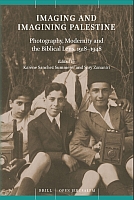Imaging and Imagining Palestine
Photography, Modernity and the Biblical Lens, 1918–1948
Contributor(s)
Sanchez Summerer, Karène (editor)
Zananiri, Sary (editor)
Collection
Dutch Research Council (NWO)Language
EnglishAbstract
Imaging and Imagining Palestine is the first comprehensive study of photography during the British Mandate period (1918–1948). It addresses well-known archives, photos from private collections never available before and archives that have until recently remained closed. This interdisciplinary volume argues that photography is central to a different understanding of the social and political complexities of Palestine in this period. While Biblical and Orientalist images abound, the chapters in this book go further by questioning the impact of photography on the social histories of British Mandate Palestine. This book considers the specific archives, the work of individual photographers, methods for reading historical photography from the present and how we might begin the process of decolonising photography. "Imaging and Imagining Palestine presents a timely and much-needed critical evaluation of the role of photography in Palestine. Drawing together leading interdisciplinary specialists and engaging a range of innovative methodologies, the volume makes clear the ways in which photography reflects the shifting political, cultural and economic landscape of the British Mandate period, and experiences of modernity in Palestine. Actively problematising conventional understandings of production, circulation and the in/stability of the photographic document, Imaging and Imagining Palestine provides essential reading for decolonial studies of photography and visual culture studies of Palestine." - Chrisoula Lionis, author of Laughter in Occupied Palestine: Comedy and Identity in Art and Film. "Imaging and Imagining Palestine is the first and much needed overview of photography during the British Mandate period. From well-known and accessible photographic archives to private family albums, it deals with the cultural and political relations of the period thinking about both the Western perceptions of Palestine as well as its modern social life. This book brings together an impressive array of material and analyses to form an interdisciplinary perspective that considers just how photography shapes our understanding of the past as well as the ways in which the past might be reclaimed." - Jack Persekian, Founding Director of Al Ma'mal Foundation for Contemporary Art in Jerusalem. "Imaging and Imagining Palestine draws together a plethora of fresh approaches to the field of photography in Palestine. It considers Palestine as a central node in global photographic production and the ways in which photography shaped the modern imaging and imagining from within a fresh regional theoretical perspective." - Salwa Mikdadi, Director al Mawrid Arab Center for the Study of Art, New York University Abu Dhabi. Readership: Anyone interested in the Middle East, Palestinian history, history of photography, Middle Eastern visual culture, religious and Orientalist imaging, decolonising photography, cultural studies, and cultural histories.
Keywords
Middle Eastern historyDOI
10.1163/9789004437944ISBN
9789004437937, 9789004437944, 9789004437937Publisher
BrillPublisher website
https://brill.com/Publication date and place
2021Series
Open Jerusalem, 3Classification
Middle Eastern history


 Download
Download Web Shop
Web Shop